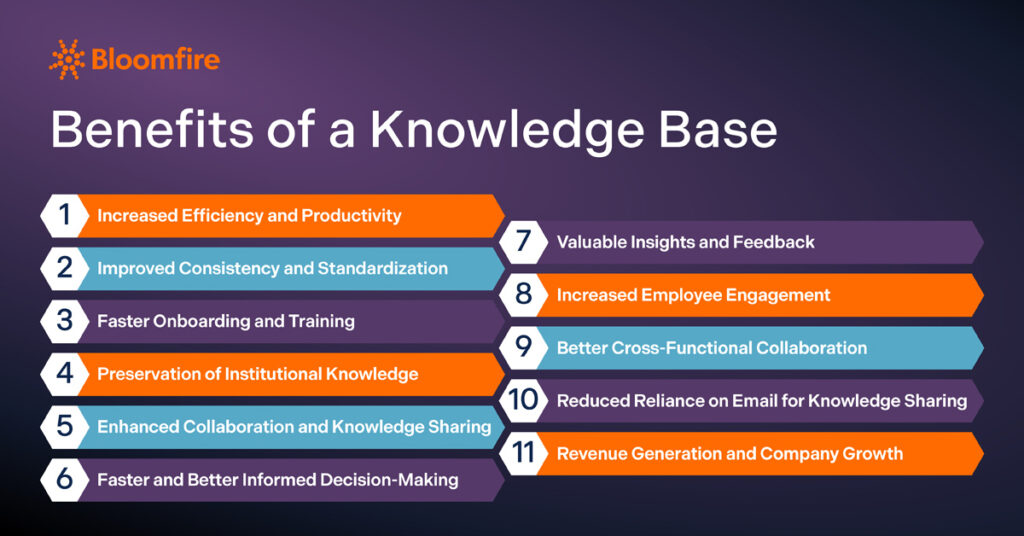11 Benefits of a Knowledge Base

Have you ever felt overwhelmed by the vast amount of information scattered throughout your organization? A well-implemented knowledge base system isn’t just a repository—it’s a strategic asset that transforms chaos into clarity. The benefits of a knowledge base extend beyond simple information storage; they empower your workforce to access and utilize critical data effortlessly, regardless of location.
If you’re considering adopting a knowledge base for your organization or just starting to explore the world of knowledge management, you’re in the right place. Below, we discuss the importance of the 11 most impactful knowledge base benefits in helping you build a compelling business case.
The Importance of a Knowledge Base in Organizations
A knowledge base lets employees across your organization share content in a central, searchable hub. In many cases, a knowledge base is part of a knowledge management software solution. For example, Bloomfire’s knowledge management platform enables users to create a dynamic knowledge base that contains documentation, FAQs, and individual expertise from across their organization.
Users can share different types of knowledge through a wide range of files and media, post content directly to the platform, search the platform for information, and ask questions of their co-workers.
A knowledge base system can be used both internally (by employees) and externally (by customers). For instance, businesses might establish an internal knowledge base to centralize their institutional knowledge and the collective intelligence of their employees, while setting up an external knowledge base to provide customers with easy access to how-to guides, best practices, and FAQs. (Note: Bloomfire’s Help Center is an example of an external knowledge base.)
Internal and external knowledge bases have benefits (and many companies use both), but this article will focus on some of the biggest benefits of a knowledge base.
11 Knowledge Base Benefits
Companies lacking strong knowledge management (KM) programs see employees spend 8-10 hours weekly searching for information, with a mean of 8.5 hours. Meanwhile, those with a KM program reduce this to 4.6 hours, effectively saving 3.9 hours per employee weekly.
At the core of these datasets lies the value of a knowledge base in a KM platform. It acts as your organization’s central intelligence hub, ensuring swift retrieval of accurate information whenever and wherever it’s needed. These functionalities give way to the following benefits of a knowledge base.

1. Increased Efficiency and Productivity
In 2022, Coveo found that employees waste an average of 3.6 hours daily searching for information in cluttered inboxes, unorganized repositories, and co-workers’ brains. These hours can be allocated to other productive activities. This is where a knowledge base system becomes critical. A knowledge base centralizes all the knowledge living in those spaces, making it accessible and searchable to all employees, resulting in faster retrieval.
No more scrolling through old Slack messages, combing through thousands of emails for a single attachment, or desperately trying to chase down an expert before they go to lunch. A knowledge base can reclaim up to an entire workday for each employee each week. Spending less time searching for information means more time for accomplishing meaningful work.
With information readily available in a well-structured knowledge base, employees experience a significant boost in productivity and work efficiency. They can locate answers independently, resolve issues swiftly, and continue their tasks without prolonged interruptions. This self-service approach reduces reliance on colleagues for information or data, freeing up their time.
2. Improved Consistency and Standardization
The frustrating scenario of a customer receiving conflicting product usage and troubleshooting advice from different sales and support representatives perfectly illustrates how a lack of standardized information leads to inconsistency. This disjointed experience, where one rep suggests a specific product application and subsequent support offers contradictory fixes, erodes customer trust and damages brand reputation.
In this case, a customer support knowledge base directly addresses this problem by establishing a single, centralized source of truth accessible to all customer-facing teams. When sales, marketing, and customer service draw information from the same knowledge base, they are equipped with consistent, standardized answers regarding product features, usage, and troubleshooting.
In the scenario above, a well-maintained knowledge base would ensure the initial sales guidance aligns with recommended support procedures, and all customer service representatives offer the same, verified solutions. Such a unified approach provides an enhanced customer experience, fostering trust and loyalty rather than frustration.
One of the knowledge base’s advantages involves its role as the bedrock for consistent communication and standardized processes across all customer touchpoints. This prevents the costly errors and customer dissatisfaction that arise from disparate and siloed information.
3. Faster Onboarding and Training
Organizations are increasingly focused on employee retention, with 90% expressing concern about keeping their talent. The 2024 LinkedIn Workforce Learning Report highlights providing learning opportunities as the top strategy for retaining employees. Traditional training, however, can be time-intensive, pulling new hires and existing employees away from their core responsibilities.
In contrast, an internal knowledge base directly accelerates onboarding and training by offering on-demand learning resources. Instead of solely relying on time-consuming live sessions, companies can build a repository of easily accessible information. While training managers might still conduct live sessions, recording these and uploading all related materials (videos, documents, FAQs) to the knowledge base allows new hires to learn at their own pace and revisit information as needed.
The searchability of a comprehensive knowledge base enables employees to quickly locate specific answers and guidance, reducing the time spent waiting for assistance or sifting through irrelevant content. New employees’ immediate access to targeted information empowers them to become productive faster. It allows all staff to reinforce their knowledge efficiently within their workflow, minimizing disruptions and accelerating the learning process.
4. Preservation of Institutional Knowledge
As employees leave the organization for various reasons (retirement, job change, or even temporarily for vacation or parental leave), you risk losing the valuable knowledge they acquired during their tenure. This creates problems for those tasked with picking up the pieces.
You need a proper system to handle knowledge transfer to avoid this loss. A knowledge base empowers employees to document every project they complete thoroughly, including the content they write, the questions they answer, and the protocols they develop, so that transferring tasks and information from one employee to another is straightforward.
Additionally, a platform that lets users share content in many different formats (image, audio, video, etc.) makes it easy for subject matter experts to share and preserve their knowledge most conveniently.
5. Enhanced Collaboration and Knowledge Sharing
Modern collaboration doesn’t always happen in an office from 9 to 5. Remote work has become a standard part of many employees’ lives today. According to the Pew Research Center, approximately 22 million employed adults in the U.S. work from home full-time, accounting for roughly 14% of all employed adults. Additionally, just over one-third of U.S. workers who can work remotely do so full-time, while 41% work on a hybrid schedule. It’s projected that more than one in five Americans will work remotely by 2025.
Regardless of where employees work, they require access to the necessary information to perform their jobs effectively. A cloud-based and mobile-friendly knowledge base ensures remote employees can access company knowledge from anywhere. This is particularly crucial in organizations that adopt a hybrid or flexible work model, empowering employees to access the information they need when needed without disrupting co-workers who might be offline.
Implementing a knowledge base is essential for accessing time-sensitive company information, such as when a sales representative conducts a product demo or a remote customer service representative assists a customer with a return policy question. When a company’s reputation depends on timely customer service, employees must be able to quickly find the answers needed to resolve queries and issues efficiently.
6. Faster and Better Informed Decision-Making
Your organization likely possesses a wealth of data and insights, but can everyone access them? In many cases, insights and research reports are shared with a limited audience through presentations or emails and then forgotten about or buried.
When decision-makers have a specific research question, they must dig through their inbox or track down a subject matter expert who can help them find the needed information. This slows down their decision-making process, leading them to make more decisions based on assumptions rather than available data.
With a knowledge base, internal stakeholders can quickly search for and surface answers to their research questions, empowering them to make faster, more informed business decisions. Effective knowledge management, facilitated by tools such as a knowledge base, significantly enhances the quality and speed of decision-making throughout the entire organization.
7. Valuable Insights and Feedback
Employees across all levels and departments can contribute their expertise, documenting solutions, best practices, and project outcomes directly within the system. The collective input transforms the knowledge base into a rich source of information reflecting the organization’s accumulated wisdom. The ease of contribution also encourages individuals to share their unique insights, preventing valuable knowledge from remaining siloed within specific teams or individuals.
The structure of an employee knowledge base often facilitates feedback mechanisms directly associated with specific content. Users can comment, ask clarifying questions, and offer alternative perspectives on existing articles or solutions. The documented discussions and feedback loops become valuable assets, highlighting common challenges, areas of confusion, and potential improvements identified through the practical application of the knowledge.
Moreover, analyzing the contributions and feedback within a knowledge base can reveal broader organizational trends and areas for improvement. Identifying frequently searched topics, recurring questions, or highly rated solutions can highlight knowledge gaps or areas of expertise.
8. Increased Employee Engagement
Employees who feel engaged with their work stay at one company longer, have lower absenteeism rates, and produce higher quality work than their disengaged peers. One way to help keep employees engaged is to give them access to a company knowledge base.
Centralizing company knowledge within a knowledge base underscores organizational transparency, cultivating employee trust. When individuals can see the work of different teams and understand how their contributions align with overarching business objectives, they feel more informed and invested in the company’s success.
Furthermore, a collaborative knowledge base empowers employees to actively contribute their expertise and insights. Modern knowledge base platforms, such as Bloomfire, offer features that facilitate seamless knowledge sharing, including commenting, liking, tagging, and following content or contributors.
Regardless of physical location, this digital space enables real-time collaboration on projects and the exchange of ideas. It also ensures that all employees feel their voices are heard and valued, further solidifying trust and encouraging a culture of shared knowledge.
9. Better Cross-Functional Collaboration
The demand for better internal collaboration is taking center stage, with 54% of global marketing leaders prioritizing it. Additionally, at GDS Group’s RevGen Digital Summit in North America, 59% of senior executives emphasized the importance of trust within sales, marketing, and the entire organization.
Improving cross-functional collaboration can be challenging. From decentralized workforces to different sources of records for various teams, obstacles to effective collaboration abound. A knowledge base can help tackle these challenges by providing employees across departments with a single digital location where they can come together and share information.
Furthermore, through a knowledge base, organizations foster a culture of proactive collaboration, empowering employees to work closely with other departments on specific projects. By doing so, they rely less on individual knowledge silos and ensures that valuable experience is captured and readily accessible to others.
10. Reduced Reliance on Email for Knowledge Sharing
Organizations ought to foster a culture where employees instinctively share helpful information within a knowledge base, benefiting a wider audience and future team members. Cultivating the habit of proactively posting potentially useful knowledge prevents its isolation within individual email threads. Consequently, subject matter experts experience a reduced need to address identical queries repeatedly, streamlining their workload.
Sharing content through a knowledge base eliminates one of the most significant problems with sharing content over email: version control. When you share a document via email and your recipient makes edits, they must resend the most up-to-date version. Multiple people may sometimes work on the same document, resulting in numerous versions floating around the company. There may also be various one-to-one conversations about the document occurring over email, with important information about the content becoming siloed.
Utilizing a modern knowledge base with version control ensures all employees access the most up-to-date content and view document changes over time. With this capability, you can remove duplicate efforts and keep everyone aligned around the same knowledge.
11. Revenue Generation and Company Growth
That’s right–a knowledge base can contribute to revenue generation and company growth. When employees spend less time searching for knowledge and more time applying it, they become more productive and produce higher-quality work. They can also reduce duplicate or redundant work because they have a better understanding of what everyone across teams is working on.
Having a centralized source for knowledge sharing also contributes to innovation. Employees can build upon one another’s knowledge and connect information in new ways. This becomes a competitive advantage for your business, leading to revenue and company growth.
A robust knowledge base enhances customer satisfaction, a critical driver of revenue and a return on investment (ROI) knowledge management metric. When customer-facing teams have immediate access to comprehensive and accurate information, they can resolve inquiries more quickly and effectively, leading to happier customers and increased loyalty. The chances of repeat business and positive word-of-mouth referrals increase, contributing to long-term revenue generation and a strong brand reputation.
Improving Performance Through a Knowledge Base
The knowledge base benefits mentioned above stem from the system’s ability to centralize all company knowledge, making it easily searchable and accessible. This means that Customer Service can resolve issues more quickly, Marketing can craft more compelling content, Sales can expedite closures, and Insights teams can disseminate findings more efficiently. When employees are empowered to do their jobs faster and more efficiently, your company’s customers and partners also benefit.
This post was originally published in August 2017. It was most recently expanded and updated in May 2025.
Take Advantage of Your Knowledge Base
Leverage the advanced features of Bloomfire to expand what your knowledge base can do!
Talk to an Expert

Developing a Codification Strategy in Knowledge Management: A Comprehensive Guide

How To Improve Customer Retention With Enterprise Intelligence

10 Types of Knowledge Management Systems

Start working smarter with Bloomfire
See how Bloomfire helps companies find information, create insights, and maximize value of their most important knowledge.

Take a self guided Tour
See Bloomfire in action across several potential configurations. Imagine the potential of your team when they stop searching and start finding critical knowledge.